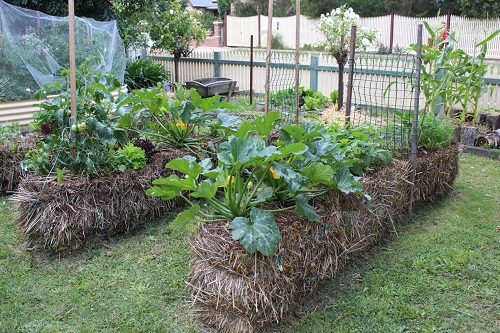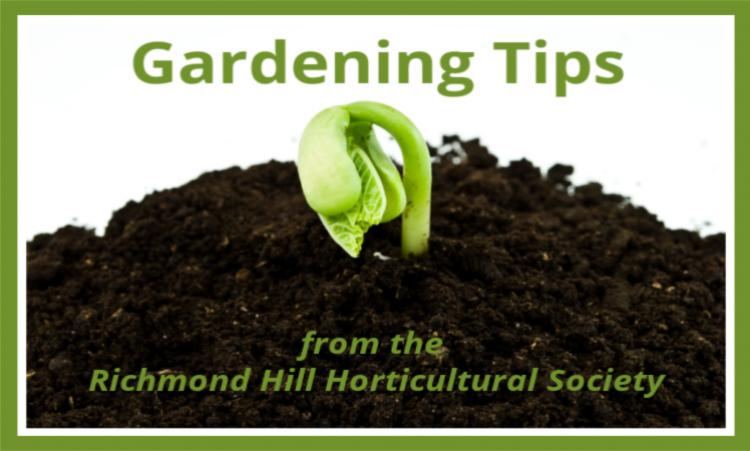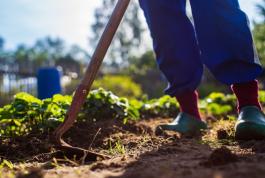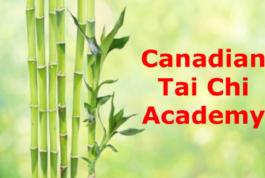Submitted by Doreen Coyne, a member of the Richmond Hill Garden & Horticultural Society
Last year one of our monthly speakers was a teenager, Emma Biggs, well known for growing tomatoes in downtown Toronto. She spoke of how to grow them, get the best yield even in a small garden, and how to harvest the seeds to start the next season. Although it wasn’t a part of her talk, one of her photos showed plants growing from within a bale of straw. This got my interest being raised in the tomato capital of Canada! And thus, I began my quest for finding out if using straw was common.

Many gardeners, especially vegetable gardeners are using straw as mulch. The benefits are many:
- It covers the ground to effectively stop weeds from growing. The reasoning is that the straw blocks out the sun, preventing most weeds from germinating and growing. BTW: That also means do not put straw on top of newly plants seeds until the plants have grown to a fair size and then keep it about 2” from the stocks with only a light amount around the plants.
- Straw composts slowly enriching the soil. For tomatoes, when soil moisture stays even calcium can be transferred from the soil to tomatoes more easily, preventing disease.
- It keeps the soil moist so plants don’t dry out as quickly and thus need less watering. This also keeps the soil moist and workable.
- It releases its nutrients including nitrogen so they can be easily absorbed into your plants and the soil beneath the straw. Thus. less fertilizer is needed.
- Additionally, it can serve as the growing media keeping fruit and vegetables off the ground to avoid root rot. This works well for strawberries, tomatoes, peppers, zucchini, and squash.
- And I’m sure you can see that these benefits will also save you time.
What exactly is straw and could you use hay instead?
Straw is an agricultural by-product consisting of the dry stalks of cereal plants after the grain and chaff have been removed. Straw is dried and baled when harvested and therefore less likely to mold or attract moisture. Straw is less expensive. Farmers might use it in nesting material for hens, or ground cover in chicken coops. Hay is grass, legumes, or other herbaceous plants that have been cut and dried to be stored for use as animal fodder (food). That may mean that hay also has been sprayed with herbicides or pesticides. Another thing to note about hay is that it typically contains seeds, often weeds. The last thing you want to do is add a source of weeds to your garden. So please use straw.
Straw round plants. My son made a vegetable garden in my backyard last summer. It grew a lot of good vegetables but also grew weeds. This year I suggested laying straw around the base of the plants and in the rows between plants once the seedlings were a reasonable size. No weeds! And they need less watering. We did NOT put straw in my radish, carrot, nor green onion beds as they are grown from seed and shouldn’t be covered.
Spots to encourage grass seed to grow. We thought about repairing a few bald spots in the lawn left when two trees died. We prepped the soil, added seeds and some topsoil then a very light covering of straw to keep the ground moist in the hot days we had this past spring. A few weeks later the new grass had taken hold and was growing well. We then removed the straw so as not to choke out the new grass. Straw goes a long way; we still have half a bale in the garage! It was purchased at a local nursery for $12. When I googled to find some, several big box stores and nurseries were selling it.
Growing potatoes in straw. A friend who uses it for growing potatoes told me she uses a foot or two of straw atop the potato bed to grow clean potatoes that can be easily harvested. Because potato roots are shallow, tubers form in the straw and she reports that her crops are always bigger when she uses straw as both mulch and soil media. Maybe I’ll try that next year. Another simply puts straw on the ground under her pepper and tomato plants so that the ripened fruits and vegetables won’t get blemished. The same works for zucchini, squash, melons, and pumpkins.
So back to the beginning. Why did Emma Biggs have some of her plants growing in bales of straw? Remember this was not a part of her presentation but something that caught my eye. I believe they were used as ready-made planters. Simply place them on the ground (you could even put some cardboard under them to stop weeds from coming from the ground below) then add good-sized seedlings. No need for soil. A wise use of space and time. Nutrients come as the bales compost. Moisture is retained for less watering. Few weeds can germinate and grow. And the straw will decompose!
Planting directly in a straw bale. Plant seedlings by creating a hole in the bale deep and wide enough to accommodate the roots, and insert the root ball directly into the cavity. Add a little soilless mix to protect them if needed. If you are sowing small seeds, you can plant them into a bale by laying down a thin layer of sterile soilless mix over the top of the bale and covering the seeds with a light dusting of the mix. Larger seeds (peas, beans, and squash) can be inserted directly into the bale to a depth of around the second knuckle on your finger.
Turns out that straw is the new vegetable grower’s mulch!









